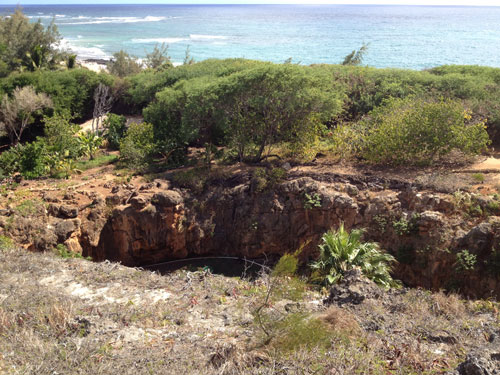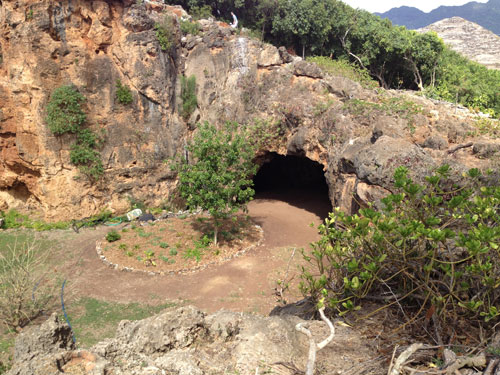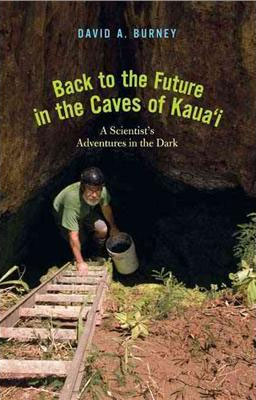Hawaii is the endangered species capital of the United States, according to paleoecologist David Burney, author of Back to the Future In the Caves of Kauai (Yale, 2010). Closely associated with the work of the National Tropical Botanical Garden (NTBG), Burney and his wife, Lida, also an archeologist, have spent over three decades studying ancient sites around the world looking for answers to the question, “What is it about human arrival in any place that is so inevitably troublesome for nature?” Since 1992, their focus has been the Makauwahi Cave, an ancient volcanic sinkhole adjoining Mahaulepu Beach on the south shore of the island of Kauai, the oldest of the Hawaiian chain. Here they asked, “What has happened there in recent millennia and might happen in the near future, and what can this tell us about the rest of the planet?”
When I was first told about the work at this site by a guide at the nearby Allerton and McBryde Gardens, I was only mildly intrigued. What’s the big deal excavating an area that at most was only occupied by humans for 800 to 1,000 years, and before that no large mammals, and limited plant life? How could anyone get excited about the tedious work of taking deep core samples of earth to sift through in search of bone fragments from extinct birds, shells from extinct snails, and plant pollen also from extinct plant species? But, at the prompting of my guide, and as the cave was located within only five miles of the place where I was staying for three weeks, I purchased an autographed copy of Burney’s book at the NTBG shop.
Several times I would pick up the book and try to get enthused about its contents. Finally, I decided to go on a day excursion with Lesley to visit the cave site. Our concierge didn’t even know about this ‘famous’ place; rather, she pointed us to a more well known cave along the highway 50 miles distant in Hanalei. We looked at the book and said, “Nope, that can’t be it.” In fact, Makauwahi cave was on a nearby horse ranch adjoining our favorite beach. Once part of a huge sugar cane plantation, it was now only accessible along bumpy dirt washboard roads (“Shh! don’t tell the car rental company!”).
After navigating a few especially deep ruts, we came to a place that we thought might be the site described in Burney’s book. This was confirmed when we saw a small sign and a wayside stand with a free guide-map for a trail around the path of the cave. The only other inquisitive folk joining us on the tour were a wonderful family of Japanese.

Indeed the trail was wonderfully marked and the pamphlet informative enough as we hiked along. In the near distance I could see the inviting white sands of Mahaulepu Beach, our ultimate destination. In the meantime we circled the periphery of a deep sinkhole with digging and excavating equipment and deep holes scattered along its sides. This was indeed a perfect place for the sands of time and seas to sweep in and around; there was even a small inlet stream with a swampy area and small bridges conveniently placed for our easy crossing. Considering that Burney was unable to secure funding from the NTBG and wound up raising money to complete this project himself, I offered silent thanks for a job truly well done.
What caught my attention and impressed me most besides the breathtaking vista of a huge crater with mountains circling what was once a mammoth sugar cane field was that the area surrounding the cave was planted with endemic Hawaiian species matching the ancient plant fragments and spores that Burney and company unearthed in the cave below. He is actually trying to ‘rewild’ this area, as it is called in paleoecology terms, by weeding out non-endemic species and planting threatened native plants. An elaborate irrigation system was in place to allow these plants to get started, but will eventually be removed so things can thrive naturally as they once did over 1,000 years ago.

David Burney calls the cave a “poor man’s time machine.” So this is what is meant by the title of his book! I laud his attempt to make his book sound as exciting as “Raiders of the Lost Ark” (which it isn’t,), but the title serves wonderfully the idealistic vision embodied by a noble enterprise — one that we can all hope will catch on and endure not only on Kauai, but also on other places around the globe as we begin to take the threat of global warning seriously. The excavation and subsequent ‘rewilding’ of Makauwahe Cave and its surroundings can, in the meantime, serve as a place where visitors can experience what it may have been like before humans came to inhabit the land.
It is obvious that David Burney’s adventures in the dark muck of eons of silt, sand and debris is intended to serve as a model of what we as humans, the one species most responsible for devastating nature wherever we have set foot on this planet, can do to make amends and return it to the wild splendor of its prehuman past.
Photos by Michael Tierra

